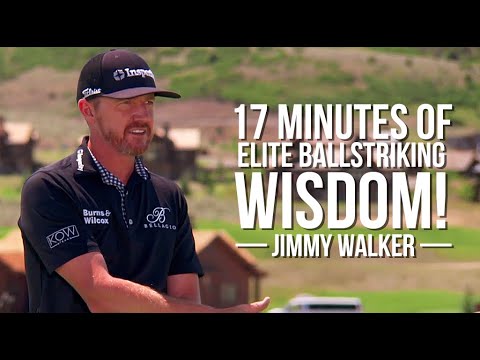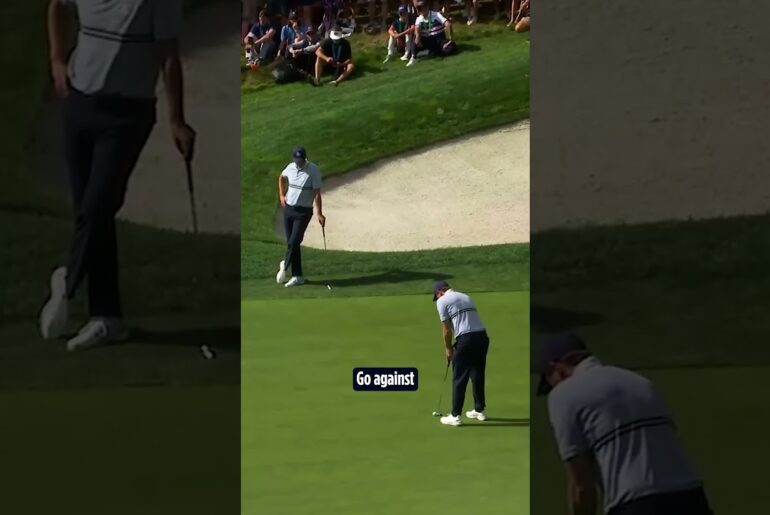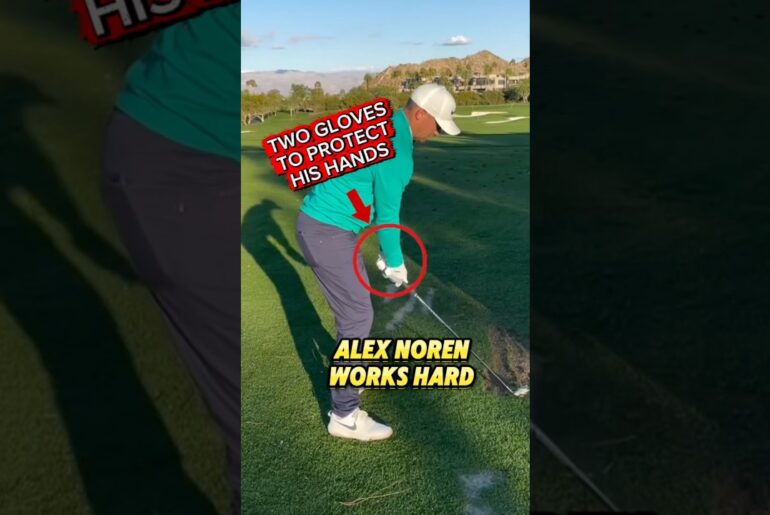Jimmy Walker explains in detail what every golfer needs to become an expert at in order to take their game to the next level and get on a professional ballstriking level. Walker talks about using the ground, how the wrists work through impact, having a go-to shot, and working the ball in both directions.
when you talk about using the ground, put that into play. Right now, what I’m doing more now is, you know, I I was really into, you know, sliding this way and um now it’s now it’s a little more getting down here and then this way. So, I’m using a little more pop instead of and turning down and turn as opposed to, you know, sliding so much. So, I’ve also kind of always kind of cut my wrist a little bit. And when I come down, I’d have open face. Yeah. Kind of have to save it a little bit. So, just a little little different wrist angle coming down. And uh it’s been been pretty good and hit nice tight draws against the wind. Now, your ball position with that club in your hand, is it is it pretty neutral? I think it’s a little up. I’ve always been just a little up, uh, neutral grip, just a fraction up, and then as the clubs get longer, you know, it gets it scoots out there a little more and more. And like I said, just kind of depends on the shot. You know, if you want to hit a lower shot, kind of more of a, you know, a little knockdown. Obviously, that ball’s more back in the stance. Same thing. Hard low draw up against the wind. So ball flight, ball position changes, should change trajectory quite a bit. When I say the word tempo, how do you associate that in your golf swing? Tempo for me is good. Good back here and then feeling the hands start to drop and everything going down towards the ball and it’s like one nice motion. Yeah. As opposed to, you know, kind of like a chop or a stop. Okay. Now, with swing 360, you mentioned about shallowing it out. What are people seeing when they’re looking at you shallow the club out on the way down? This the wrist starts to bow out just a little bit and that lets the club fall, but it keeps the it keeps the face square to the target instead of, you know, you can you can drop it out, but if you’re not if you’re not getting that wrist out this way, it’s not going to keep the club face square to the to the target, and you’re going to have to save it one way or another. Okay? down the line. You know, I would I would I would think that they could see this this leg move more out this way, this left leg. So, you’ll see it come into frame a little bit better. Then hopefully that you’re going to see more of this you won’t see it like slide out that way. You’ll see it more down this way. The head will drop down just a little bit because I’ve I’ve always kind of at impact stood up on it like this and my head kind of rises up. So, I’m trying to get everything more back this way. Use the ground, get it going instead of coming up at it. I think there should be a little bit of squat down like that. You know, I want this leg going down cuz I want to feel like I’m stepping on something. Everything is going to go down like that. First bunch of times I did, I was really fatting it a lot. That was anything but fat. All right, much more to do, including shaping shots. Somebody who grew up in the state of Texas, played college golf there, better know how to do a lot of this. He can. We’re back right after this. You’ve always been one of the longer guys on tour over the last 20 years. What are the keys for you with the driver? It’s having a go-to shot that you can, you know, everybody calls it the fairway finder. Just a shot that you feel like, man, if if things aren’t good, I can get this in the fairway and we can keep going. And the other one is just being able to just let it go. you know, having that confidence to stand up there and say, you know what, man, I’m swinging it. Let’s just have a rip at it and it goes where it it’s going to end up where it’s at. And having that confidence to do that is going to lead to you hitting it better and better and better. That just kind of carefree sended attitude. Now, that tight draw, that is the flight that you want. The difference between a driver swing and an iron swing. What is it for you? Driver swing and iron swing are totally different because iron swing, you’re using the ground a lot more. You know, your down angles are, you know, between like three and seven, whatever it is, depending on the club you’re hitting, you know, as you start getting longer, it’s going to shallow out, you still want to be hitting down on it with the irons, fairway woods, too, because it’s off the deck. It’s hard to swing up when it’s sitting on the ground. So, those are the big differences. And I’ve always just, you know, I’ve gone this way and I can get really under the ball. And I mean really under it. So it’s more about me staying this way on top of the ball and hitting more line drives and not these like gigantic high bombs that can get away from you. Okay. Spine tilt. When you started working with Butch Harmon and you had a great run with him, did you work on changing your spine tilt with him? He wanted me to keep my keep my rear out more on the way down. And I, you know, I think that was that was the way of of telling me to, you know, to get to get this here and keep the head in it. And he was big on me releasing the head with the shot. And we did really good work with that. Uh, just getting me to clear out better. Okay, let’s see one more and then we’re going to make a a change here. Another good one. Now, grab that 3-wood because I I want you to talk about what people are seeing that is different terms of hitting off the ground as opposed to that driver with the tea. Kind of close to the same, you know, a 3-wood off the deck. You can kind of just pick it right off there. You can take a little divot. You know, there’s everything kind of in between, but you’re looking for just a nice solid strike with the 3-wood. Uh, that was a little too thin. But a lot of it just depends on is it a max carry, is it a force carry? It’s easier to kind of get a cut high and up and hammer a cut as opposed to a nice tight draw off the deck and get it high. So, it’s and it depends on what your 3-wood is and what it’s built to do. You know what I mean? Not hitting a lot of 3woods into par fives. Okay. when you were showing down the line with the alignment. Are you pretty squared up or are you slightly open? Yeah, I mean for a for a tight draw, I mean, I’m pretty much right at it. Just a little right of it, I think. And then, you know, I’m going to be delivering the club from the inside to out with the face just shut a, you know, just shut a little bit. And it should just have the nice tight draw like that. Yeah, just like that. Now, I want you to tee that 3-wood up. What are we talking about? The difference between teeing up that 3-wood and a driver. You know, this 3-wood is designed more off the tea than attacking a par five and two. So, you’ll be able to get under this one a little bit more, maybe a little fraction more up in your stance. And then just put all that other stuff in there. A lot higher. Put more draw on it. It’s another nice tight draw. And yeah, that is the go-to, but he can shape it one way or the other. That’s coming up. It’s time for Golf Academy Unplugged. Let’s drop in on Gary and Jimmy for a behindthe-scenes chat on the range. All right. We We’ve got wind out here, but if I said to you, where’s the place that you play that you can just hit full shots the whole week? It’s probably Palm Springs. I don’t play it a lot, but every time you go there, it’s it seems like you’re playing in a dome, you know, kind of a deal. Okay. I remember playing Q school out there a long time ago, and it was crazy calm the whole week. And then we got one little windstorm that hit for like two holes and then it flattened back out. So that’s probably I mean Texas it’s always blowing. Florida it’s always blowing. It’s always blowing somewhere but that’s it’s a weird spot there. Yeah. The PGA in 16 you had some weird weather that week. You had some rain. Did you get affected by delays that week? Saturday I didn’t even play and had to play 36 on Sunday. Okay. So, yeah, I went out and did basically full warm up and got about I’d say 3/4 of the way through it. Okay. And then they called it. So, Sunday was full 36. So, it was a long day, but I had a good break in between, which I got to go back and actually took a nap, which is kind of cool at at my bus. So, it was a uh and we played it up that day cuz they had gotten a lot of rain and it was just a rough week on the golf course, but they did a good job of, you know, getting everything together and fans stayed and the volunteers crushed it. So, it was it was a good week. Okay. Uh hit hold something up against this win. Hold a try to hold something up against that you I don’t know if you What do you got in your hand? I had a seven. Okay. Can you get seven of that black flag? Uh it might get close. So, I’ll see if I can hood her down and get her in there. See, I don’t know how far that is, but it looks pretty far. So, I’ll kind of throw this back in the back of the stance, and I’m going to hit this low rip draw out there. See if I can get her there. Might not have the height, but it held just short. We’re pretty good. Almost. 12 feet left. Yeah, pretty good wind. It is a pretty good wind. Now, when you’re out here and it’s blowing like it is, this is not a fun wind, is it? It’s not. You know, up here at altitude, the wind isn’t quite as heavy, I don’t think, as opposed to like when you’re down in like Florida or in Scotland, you’re at sea level and they’re so much heavier and thicker that, you know, the ball’s got a lot to grab onto. Up here, it just doesn’t grab onto it as much. So, you can get away with some end of the wind shots where you flight it and you’re like, “Ah, can I get this there into the wind?” Usually, it gets there. So that’s kind of the difference I think here at altitude as opposed to like sea level. Okay. Now I turn turn one over into this wind like just a nice high one. Yeah. Okay. I mean that is so pure. It came up shorter than that last one, but the same same spot, you know, but that was I mean that that as far as how solid that strike was, that was that was right in the center of the face. Oh, yeah. Smashed it. But that’s, you know, that’s the difference on, you know, flighting that down, turning this into a, you know, sixiron and really roasting it. Yeah. What else you want to see? I I I want to see a high cut. High cut. Yeah. I cut with this wind. You don’t have to cut it much. Just kind of think about it a little bit. You’re right. You didn’t have to do much. No, it a little bit. I rode it pretty good. Kind of caught a little downwind maybe there. Okay. Now, I I want you to I I don’t want you to hit like a a violent, you know, trying to get to the ground as fast as possible, but I want you to turn the ball over right to left as much as you can without manipulating it to where it looks like a shrimp. Okay. Try to hit it a little higher. Yeah, like that. That’s pretty good. Yeah, it is. [Music] You know, people ask me what width is, and I think to me, width is getting the arm getting the arms away from the body and getting a big turn. So, you’re you’re moving your arms away from your chest. You know, just trying to think about getting as far away from your chest as possible. To me, that’s really good width where you can start to see the back and you’re not uh, you know, it’s not your body’s not here and you’re getting width. It’s everything’s going out and away from the ball like that. To me, that’s really good width [Music] and width on the follow through, too. You don’t want to You don’t want to kind of, you know, just do this, you know. I think a good, you know, down the line width is good, too. Now, Jimmy, at impact with an iron in your hand, what what does your impact position ideally look like? I think it’s going to, you know, when when you’re starting down and you’re coming down, I think that this is, you know, in a perfect world, I think that that’s kind of where it’s going to be somewhere right in there. Draw fade. Uh, it should look about the same. That’s kind of it. Um, a good solid contact at the back of the ball, compressing the ball, hitting down on the ball. Um, those have been kind of the key things that I’ve been working on. Compression and making sure I’m staying down hitting through the ball. If it’s a little heavy or a little thin, what what is the subtle difference that it’s going to look like at impact? You know, I think usually when you usually when I hit one fat, it’s it’s everything’s kind of I’ve gone this way, okay? and I come in and I I just get way underneath it and I end up, you know, kind of hitting like a drop kick or a fat shot. Thin shots or I may have gotten a little too, you know, I may have started back down a little too quick and I’m catching the ball first a little too much. Usually don’t hit many thin draws. They’re always kind of like these little Oh, okay. That was cute. You know, so try not to do that. Always try not that cute, actually. Yeah, that was cute. All right. Now, you you mentioned the draw, and that is everybody at your level has got to have a go-to. How do you hit that go-to tight draw with that club in your hand with the eight iron? If you want to hit like the go-to, I think you always kind of try to flight one a little bit. So, if I’m going to hit that kind of go-to draw a little bit, ball’s going to be back in the stance a little bit more. You get the weight set maybe a little more on that left side. You got to hit down and stay stay through it pretty good. Abbreviated follow through. Keeping it low, keeping it tight. And obviously, you know, that shot’s going to depend on where the pin is and the green and and all that, but I mean, that’s a pretty solid go-to shot. Oh, yeah. Sure it is. Now, look, that’s your go-to. Now, if I say, now I want you to with this wind, I want you to hit a little bit of a bleeder, a little bit of a fade. And I’ve got that at 172, but with the atmospherics, we’re outside of Park City, Utah at Victory Ranch. So, it’s playing effectively 155. And you’re down off the left. So, what are you going to adjust? Yeah, if you know, if it if it’s a nice back kind of right pen, I’ll be aiming out in the middle of the green. So, I’m going to adjust my my body line, which is going to be more out to the left. And I’m going to swing down that that that body line. And that face is going to be I’ll have the club face just fractionally open of where I want it to be. If this is kind of a higher shot, it’ll be more kind of up in the stance and just all the same stuff again. And that ball should just fade right onto target. Little up and outside. That ball just fades right in there. Sure does. So, you’re following your body path a little bit more. A little more up and out on the takeaway. A little more left on the follow through. Um, and that’s going to give you that nice little fade. Now, what is a drill that somebody could use on the range? Now, here at Victory Ranch, you’ve got these alignment sticks, but you’ve got a couple in your bag. Is that something you can use? Yeah, I think for everybody, you get your target line. So, we’re going at that that white flag out there. So, I’ll just stick this guy out here like that. And so, when you get in here to hit your shots, you come back here and look at like, wow, that thing’s right in the way. So, if I want to hit a draw, you know, you’ve got to get that ball started right at that stick right there. So, you get everything set up. Big old gust of wind. And that’ll really help you have the sensation of, man, I got to go I got to go out and around that thing, you know, really hard today. I’m going to let you hit the fade, though. Thanks, that thing’s right in the right in the way. This is definitely a lot easier. Like you got to get left to that sucker. Let it go. It’s ripping out here now. There’s no wonder you love spending the summers here with your family. Thanks for having us at your summer home. Thank you, guys. All right, we’ll see you next








1 Comment
I will never understand how you Americans can tolerate so many commercial breaks